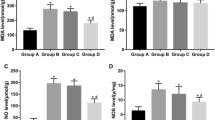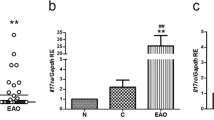Abstract
Objective
The aim of this study was to investigate the role of adhesion molecules in epididymal injury induced by ischemia-reperfusion (I-R) in the rats.
Study design
About 20 male Sprague-Dawley rats were separated into two groups. A sham operation was performed in group 1 (control). In group 2 (I-R), following 6 h of unilateral spermatic cord torsion, 1-h detorsion of the testis was performed. Then, epididymides were removed to measure the tissue levels of malondialdehyde (MDA) and to make histological examination.
Results
Malondialdehyde values increased in group 2. In group 2, the rats demonstrated significant disorganization of the epithelium and loss of microvilli in the epididymal tissue. No abnormal microscopic findings of the epididymis of the rats in the control group. The tenascin expression in the interstitial area of the epididymis was intense in group 2. Intercellular adhesion molecule-1 (ICAM-1) expression by intense brown staining was seen along the basement membrane in epididymal tissue from I-R group rats. The microvillus sites of the epithelia in I-R group were stained mildly by lectin.
Conclusion
The increased expression of adhesion molecules found in epididymal injury induced during of postischemic reperfusion may implicate importance of inflammatory infiltration.




Similar content being viewed by others
References
Williamson RNC (1985) The continuing conundrum of testicular torsion. Br J Surg 72:509–510
Turner TT, Brown KJ (1992) Spermatic cord torsion: loss of spermatogenesis despite return of blood flow. Biol Reprod 49:401–407
Lysiak JJ, Nguyen QAT, Turner TT (2000) Fluctuations in rat testicular interstitial oxygen tensions are linked to testicular vasomotion: persistence after repair of torsion. Biol Reprod 63:1383–1389
Prillaman HM, Turner TT (1997) Rescue of testicular function after acute experimental torsion. J Urol 157:340–345
Molitoris BA, Marrs J (1999) The role of cell adhesion molecules in ischemic acute renal failure 1–2. Am J Med 106:583–592
Lo HP, Ackland-Berglund CE, Pritchard KA Jr, Guice KS, Oldham KT (2001) Attenuated expression of inducible nitric oxide synthase in lung microvascular endothelial cells is associated with an increase in ICAM-1 expression. J Pediatr Surg 36:1136–1142
Ponta H, Sherman L, Herrlich PA (2003) CD44: From adhesion molecules to signaling regulators. Nat Rev Mol Cell Biol 4:33–45
Wasowicz W, Neve J, Peretz A (1993) Optimized steps in fluorometric determination of thiobarbituric acid-reactive substances in serum: importance of extraction pH and influence of sample preservation and storage. Clin Chem 39:2522–2526
Lowry OH, Rosebrough NJ, Farr AL,Randall RJ (1951) Protein measurement with the folin phenol reagent. J Biol Chem 193:265–275
Young CS, Palma JM, Mosher BD, Harkema J, Naylor DF, Dean RE, Crockett E (2001) Hepatic ischemia/reperfusion injury in P-selectin and intercellular adhesion molecule-1 double-mutant mice. Am Surg 67:737–744
Bedford JM (1994) The status and state of the human epididymis. Hum Reprod 9:2187–2199
Yeung CH, Cooper TG, Oberpenning F, Schulze H, Nieschlag E (1993) Changes in movement characteristics of human spermatozoa along the length of the epididymis. Biol Reprod 49:274–280
Schoysman R, Bedford JM (1986) The role of the human epididymis in sperm maturation and storage as reflected in the consequences of epididymovasostomy. Fertil Steril 46:293–299
Silber SJ (1989) Role of the epididymis in sperm maturation. Urology 33:47–51
Palladino MA, Powell JD, Korah N, Hermo L (2004) Expression and localization of hypoxia-inducible factor-1 subunits in the adult rat epididymis. Biol Reprod 70:1121–1130
Kristo BA, Palmer JS, Cromie WJ (1999) Possible mechanisms for epididymal sparing during testicular ischemia. Urology 53:435–439
Zhao YG, Zheng XM, Yang ZW, Li SW, Hu LQ (2003) The change and implication of epididymis sialic acid following torsing/detorsing testes in rats. Zhonghua Nan Ke Xue 9:429–430
Lievano G, Nguyen L, Radhakrishnan J, Fornell L, John E (1999) New animal model to evaluate testicular blood flow during testicular torsion. J Pediatr Surg 34:1004–1006
Zimmerman BJ, Granger DN (1992) Reperfusion injury. Surg Clin North Am 72:65–83
Slater TF (1984) Free radical mechanisms in tissue injury. Biochem J 222:1–15
Erickson HP, Lightner VA (1988) Hexabrachion protein (tenascin, cytotactin, brachionectin) in connective tissues, embryonic brain, and tumors. Adv Cell Biol2:55–90
Chiquet-Ehrismann R (1995) Tenascins, a growing family of extracellular matrix proteins. Experientia 51:853–862
Jones FS, Crossin KL, Cunningham BA, Edelman GM (1990) Identification and characterization of the promoter for the cytotactin gene. Proc Natl Acad Sci U S A 87:6497–6501
Cotran RS, Mayadas-Norton T (1998) Endothelial adhesion molecules in health and disease. Pathol Biol (Paris) 46:164–170
Jeong HJ, Lee HH, Kim YS, Kim SI, Moon JI, Park K (1998) Expression of ICAM-1 and VCAM-1 in Renal Allograft Rejection. Transplant Proc 30:2953–2954
Calvo A, Pastor LM, Bonet S, Pinart E, Ventura M (2000) Characterization of the glycoconjugates boar testis and epididymis. J Reprod Fertil 120:325–335
Dettin L, Rubinstein N, Aoki A, Rabinovich GA, Maldonado CA (2003) Regulated expression and ultrastructural localization of galectin-1, a proapoptotic beta-galactoside-binding lectin, during spermatogenesis in rat testis. Biol Reprod 68:51–59
Kawakami E, Morita Y, Hori T, Tsutsui T (2002) Lectin-binding characteristics and capacitation of canine epididymal spermatozoa. J Vet Med Sci 64:543–549
Holschbach C, Cooper TG (2002) A possible extratubular origin of epididymal basal cells in mice. Reproduction 123:517–525
Author information
Authors and Affiliations
Corresponding author
Rights and permissions
About this article
Cite this article
Ozturk, H., Ozturk, H. & Dokucu, A.I. The role of cell adhesion molecules in ischemic epididymal injury. Int Urol Nephrol 40, 137–142 (2008). https://doi.org/10.1007/s11255-007-9243-5
Received:
Accepted:
Published:
Issue Date:
DOI: https://doi.org/10.1007/s11255-007-9243-5




